Chapter: Civil : Soil Mechanics -Stress Distribution And Settlement
The Principle Of Effective Stress
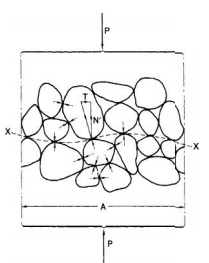
STRESS DISTRIBUTION AND SETTLEMENT
A soil can be visualized as a
skeleton of solid particles enclosing continuous voids which contain water
and/or air. For the range of stresses usually encountere d in practice the
individual solid particles and water can be considered incompressible; air, on
the other hand, is highly compressible. The volume of the soil skeleton as a whole
can change due to rearrangement of the so il particles into newpositions,
mainlyby ro lling and sliding, with a corresponding change in the forces acting
between particles. The actual compressibility of the soil skeleton will depend
on the structural arrangeement of the solid particles. In a fully satura ted
soil, since water is considered to be i ncompressible, a reduction in volume is
pos sible only if some of the water can escape fro m the voids. In a dry or a
partially saturated soil a reduction in volume is always possible due to
compression of the air in t he voids, provided there is scope for partic le
rearrangement. Shear stress can be resisted only by the skeleton of solid
particles, by means of forces developed at the interpartic le contacts. Normal
stress may be resisted by the soil skeleton through an increase in the
interparticle forces. If the soil is fully saturated, the water filling the
voids can also withstand normal stress by an increase in pressure.
THE
PRINCIPLE OF EFFECTIVE STRESS
The importance
of the fo rces
transmitted through the
soil skeleton from particle to particle was recognized i n 1923 when Terzaghi presented the principle of effective stress, an intuitive relations hip based on
experimental data. The principle applies only to fully saturated soils and
relates the following three stresses:
1.The total normal stress ( ) on a plane within the soil mass, being
the force per unit area transmitted in a normal d
irection across the plane, imagining the s oil to be a solid (single-phase)
material;
2 the pore water pressure (u), being the pressure of the water fillin g the void space between the solid
particles;
3 the effective normal stress ( )
on the plane, representing the stress transmitted through the soil skeleton
only.
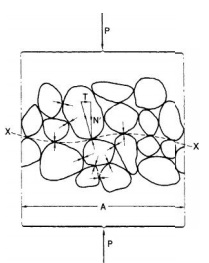
The relationship is:
The principle can be repres ented
by the following physical model. Con sider a 'plane XX in a fully saturated
soil, passing through points of interparticle contact only, as shown in Figure.
The wavy plane X X is really indistinguishable from a true plane on the mass
scale due to the relatively small size of individual soil particles. A normal
force P applied over an area A may be resisted partly by interparticle forces
and partly by the pressure in the pore water. The interparticle forces are very
random in both magnitude and direction throughout the soil mass but at every
point of contact on the wavy p lane may be split into components normal and
tangential to the direction of the true plane to which XX approxi mates; the
normal and tangential components are N' and T, respectively.
Then, the effective normal stress
is interpreted as the sum of all the components N' within th e area A, divided
by the area A, i.e.
The total normal stress is given
by If point contact is assumed between the particles, the pore water pressure
will act on the plane
over the entire area A.
Then, for equilibrium in the direction normal to XX
p=
?N' + uA
s=s'+u
The pore water pressure
which acts equally in every direction will act on the entire surface of any
Particle but is assumed not to change the volume of the particle; also, the
pore water pressure does not cause particles to be pressed together. The error
involved in assuming point contact between particles is negligible in soils,
the total contact area normally being between 1 and 3% of the cross-sectional
area A. It should be understood that N'does not represent the true contact
stress between two particles, which would be the random but very much higher
stress N', where a is the actual contact area between the particles.
2
Effective vertical stress due to self-weight of soil
Consider soil mass
having a horizontal surface and with the water table at surface level. The
total vertical stress (i.e. the total normal stress on a horizontal plane) at
depth z is equal to the weight of all material (solids þ water) per unit
area above that
sv
= rsat z
The pore water pressure at any depth will be hydrostatic
since the void space between the solid particles is continuous, so at depth z u
= rwz Hence, from Equation is the effective vertical stress at depth z will be
s =
(gsat - gw)z = gz
where g is the buoyant unit
weight of the soil.
3
RESPONSE OF EFFECTIVE STRESS TO A CHANGE IN TOTAL STRESS
As an illustration of
how effective stress responds to a change in total stress, consider the case of
a fully saturated soil subject to an increase in total vertical stress and in
which the lateral strain is zero, volume change being entirely due to
deformation of the soil in the vertical direction. This condition may be
assumed in practice when there is a change in total vertical stress over an
area which is large compared with the thickness of the soil layer in question.
It is assumed initially that the pore water pressure is constant at a value
governed by a constant position of the water table. This initial value is
called the static pore water pressure (us). When the total vertical stress is
increased, the solid particles immediately try to take up new positions closer
together. However, if water is incompressible and the soil is laterally
confined, no such particle rearrangement, and therefore no increase in the
inter particle forces,is possible unless some of the pore water can escape.
Since the pore water is resisting the particle rearrangement the pore water
pressure is increased above the static value immediately theincrease in total
stress takes place.The increase in pore water pressure will be equal to the
increase in total vertical stress, i.e. the increase in total vertical stress
is carried entirely by the pore water. Note that if the lateral strain were not
zero some degree of particle rearrangement would be possible, resulting in an
immediate increase in effective vertical stress and the increase in pore water
pressure would be less than the increase in total vertical stress. The increase
in pore water pressure causes a pressure gradient, resulting in a transient
flow of pore water towards a free-draining boundary of the soil layer. This
flow or drainage will continue until the pore water pressure again becomes
equal to the value governed by the position of the water table.
The component of pore
water pressure above the static value is known as the excess pore water
pressure (ue). It is possible, however, that the position of the water table
will have changed during the time necessary for drainage to take place, i.e.
the datum against which excess por e water pressure is measured will have
changed.
In such cases the
excess pore water pressure should be expressed wit h reference to the static
value governed by the new water table position. At any time du ring drainage
the overall pore water pressure (u) is equal to the sum of the static and
excess components, i.e.
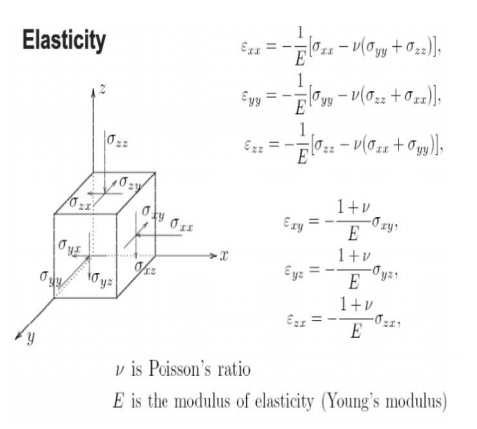
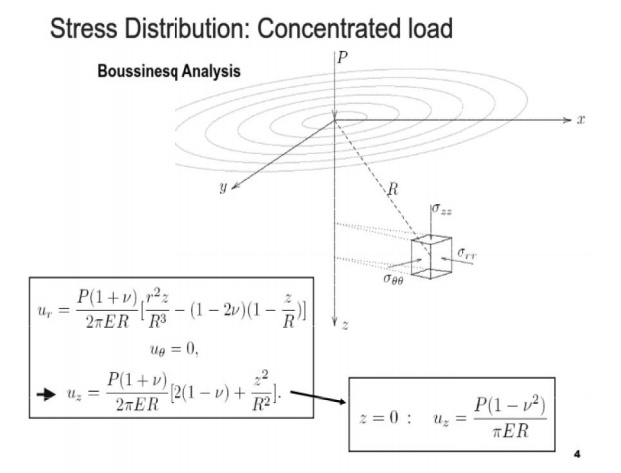
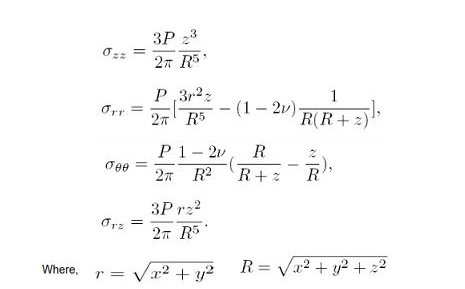
3.2.1 Vertical Concent ration
Load
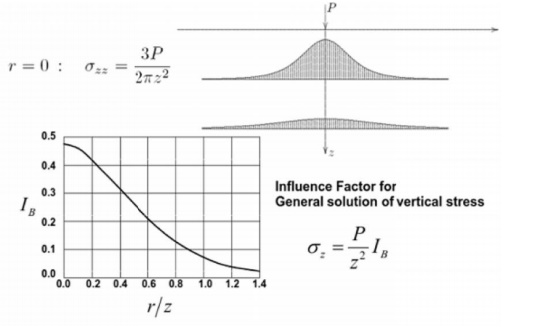
Related Topics